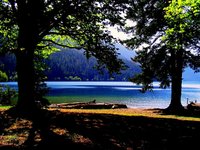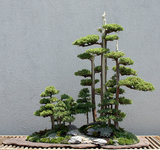thatdirtykid
Yamadori
Little introduction of myself to this small sub forum.
I went to school for art education a handful of years ago (ok a couple handfuls) and emphasized in ceramics. Toward the end of my time there I decided the bureaucracy of schools may be too much for me, that plus a few other factors I dropped the ED part of the major and finished out as a ceramics major. Toward the end while I prioritized glaze formulation, hand building and large forms I could still never get away from basic tea bowls or teapots being some of my favorite forms. I continued to work out of a community studio a couple years out of school. Starting a family and needing stability the wife and I put our art on hold, sadly that temporary hold became a lot less than temporary. Two years back I surprised her with a craigslist kiln and wheel. We goofed off a little but everything got packed away when we ended up moving soon after.
Bonsai has been of interest to me for a long time but I never jumped in due to lack of ability to prioritize a healthy work life balance, new hobbies were not an option. Well I am making the jump now and its renewed my excitement to get that "studio" back together and learn some new forms. It won't happen too fast but I am not letting the found excitement slip past this time.
I have worked almost entirely in reduction ^10 firings, including salt and soda firing. I have developed a whole catalog of my own recipes as well as favorites from everywhere I could find that will be of no use to me in this new venture. The idea of starting fresh and building a new body of work around ^6 oxidation is overwhelming but I am trying to be excited to allow myself a fresh start instead of picking up where I left off.
I have been reading about bonsai pot function, traditional styling and themes but it's still a fairly foreign direction for me. I am excited to dig through all your threads and absorb as much as I can. Just the little bit I have been reading has allowed old threads information in the back of my mind to start unraveling. Thank you all for that.
I will probably dump some photos of my old work below to complete the introduction and hopefully be a bookmark for myself to look at as reference of where I came from while building this thread as a chronological record of this new direction I hope to take my art. Hopefully no one minds some non-bonsai related pottery and sculpture to dilute the great content here.
I went to school for art education a handful of years ago (ok a couple handfuls) and emphasized in ceramics. Toward the end of my time there I decided the bureaucracy of schools may be too much for me, that plus a few other factors I dropped the ED part of the major and finished out as a ceramics major. Toward the end while I prioritized glaze formulation, hand building and large forms I could still never get away from basic tea bowls or teapots being some of my favorite forms. I continued to work out of a community studio a couple years out of school. Starting a family and needing stability the wife and I put our art on hold, sadly that temporary hold became a lot less than temporary. Two years back I surprised her with a craigslist kiln and wheel. We goofed off a little but everything got packed away when we ended up moving soon after.
Bonsai has been of interest to me for a long time but I never jumped in due to lack of ability to prioritize a healthy work life balance, new hobbies were not an option. Well I am making the jump now and its renewed my excitement to get that "studio" back together and learn some new forms. It won't happen too fast but I am not letting the found excitement slip past this time.
I have worked almost entirely in reduction ^10 firings, including salt and soda firing. I have developed a whole catalog of my own recipes as well as favorites from everywhere I could find that will be of no use to me in this new venture. The idea of starting fresh and building a new body of work around ^6 oxidation is overwhelming but I am trying to be excited to allow myself a fresh start instead of picking up where I left off.
I have been reading about bonsai pot function, traditional styling and themes but it's still a fairly foreign direction for me. I am excited to dig through all your threads and absorb as much as I can. Just the little bit I have been reading has allowed old threads information in the back of my mind to start unraveling. Thank you all for that.
I will probably dump some photos of my old work below to complete the introduction and hopefully be a bookmark for myself to look at as reference of where I came from while building this thread as a chronological record of this new direction I hope to take my art. Hopefully no one minds some non-bonsai related pottery and sculpture to dilute the great content here.



